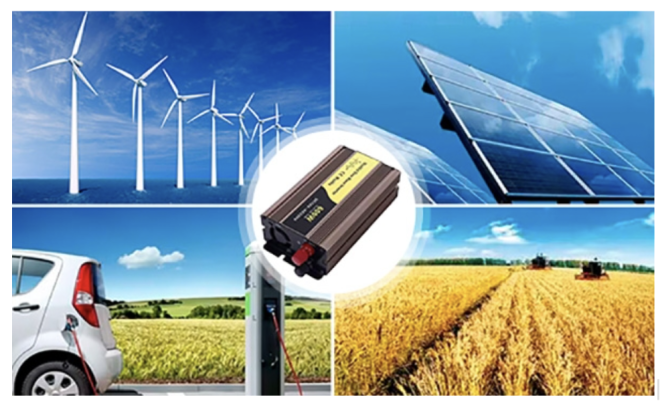How to Pick the Right Power Inverter for Your Car - Supanet

23:38 13 June 2025
Powering your devices while traveling requires reliable solutions that improve long journeys when laptops, phones, and mini fridges are essential. A suitable Power Inverter converts your vehicle's DC power to usable AC power for different electronic devices. However, not all inverters are made for every type of user, and the wrong fit might lead to poor performance or even damage to your devices.
In this article, you’ll get a practical guide to help you identify which inverter is best for your car setup. We aim to enable drivers, campers, and daily users to maintain power without any problems. Every aspect, from power ratings to plug types, gets explained through a simple and practical format.
Your car battery delivers DC (Direct Current) electricity. The majority of home electronics operate using AC (Alternating Current). A Power Inverter for cars solves this mismatch by converting the 12V DC from your car battery into 110V or 220V AC output, depending on your region.
There are two primary categories:
If you're just topping up a phone, basic inverters might suffice. Advanced electronic devices that contain microprocessors operate better with pure sine wave inverter units.
First, know what you plan to plug in. Add up the wattage ratings for your devices. If your laptop needs 90W, your mini fridge 150W, and your phone charger another 10W, go with something rated for at least 300W, plus a 20-30% margin to prevent overload.
Your car’s cigarette lighter socket usually supplies up to 150W. Anything beyond that, especially over 300W, should be connected directly to the battery. This avoids blown fuses or melted wiring.
Review the quantity and specifications of accessible ports:
A well-built Power Inverter should offer multiple ports, depending on how many devices you plan to run at once.
Heat is a major by-product of power conversion. A good inverter comes with a fan or heat sinks to maintain safe operating temperatures. Models with thermal shutoff and short-circuit protection can prevent serious hazards.
Look for features such as:
Also, consider the form factor. For compact vehicles, go for a low-profile design that fits under seats or within the glove box.
If you're looking for the best Power Inverter for your car, those three models are recommended for every user. Each inverter supports reliable power delivery while keeping your electronics safe.
This model is lightweight and compact, perfect for users who only need to power phones, tablets, or small electronics. It converts 12V DC from your car into 110/220V AC and includes built-in safety protections. Great for daily commutes and short trips.
A balanced option for moderate power needs, the 500W version comes with four USB ports, a digital display, and an internal cooling fan. It offers enough output for laptops, small appliances, and more than one device simultaneously. The safety features help maintain stable operation under different loads.
Known for its clean power output, this is the top-tier pick for powering sensitive electronics like medical equipment, laptops, or digital devices. With 90% efficiency and a compact build, it’s a popular choice for travelers who need performance and reliability.
| 300W Car Inverter | Modified Sine | Phones, tablets, and small devices | Lightweight, compact, safety protections |
| 500W Car Inverter | Modified Sine | Laptops, small appliances | 4 USB ports, digital display, cooling fan |
| 600W Pure Sine Wave Inverter | Pure Sine | Sensitive electronics, medical devices | High efficiency, pure sine output, compact |
A pure sine wave model provides a safer investment choice.
Here are some typical use cases and inverter sizes:
Keep in mind that the higher the wattage, the stronger the battery and alternator required to keep everything running smoothly.
The proper setup of your power inverter is necessary to meet safety requirements and ensure lasting performance, together with power efficiency. These guidelines will guide you through putting in place a power inverter whilst fending off common issues and achieving ideal operation.
The thickness of your wire meter determines the amount of current your car battery can provide to the inverter. Thin strands can become dangerous when they carry energy loads beyond their ability, because they can overheat or melt and lose tension when used with inverters above 300W.
Manufacturers usually specify the ideal wire meter for each inverter model, considering the power and length of the cable in their manuals. Power losses decrease when thicker wires are used for extended runs.
Don't use high-power inverters with the lighter socket because they frequently overheat and fail.
All power inverters generate heat. When installed in restricted or poorly ventilated locations, such as behind the seats or glove boxes, inverters are at high risk of overheating.
Unsurely, inverters tend to shake and move while driving, which leads to cable disconnections. The consequences of this situation can lead to electric arcs (sparks) or unintentional damage to equipment.
Mounting the inverter properly prevents vibration damage to power socket connections and battery clamps.
Never install your inverter near:
Power inverters perform electricity conversion, which creates sparks when they operate. For fire safety protection, choose a clean and stable dry location within the vehicle's cabin or trunk for the installation.
Some power inverters continue to draw a small current from your battery during idle periods. Leaving the inverter connected for hours without running the engine will slowly deplete your battery power.
Paying attention to disconnecting your power inverter when parked overnight helps protect your battery from dying in the morning.
A fuse or power switch between the battery and the inverter installation protects the vehicle and electrical devices.
- To protect the electrical system, you must choose a fuse corresponding to the current converter consumption and slightly exceeding it (for example, a 500W converter operating at 12V, approximately 42 amps; therefore, a fuse 50 A will be appropriate).
- Place the fuse near the battery terminal to reduce the length of the cord without protection.
The additional protective layer functions to avoid fire risks during incidents involving short circuits or unexpected power spikes.
Your power inverter selection should match your electronic device usage needs and travel patterns, together with the necessary protection levels for your equipment.
Power inverters enable users to perform simple functions such as charging mobile phones and running specialized equipment like medical devices. With a precise definition of your requirements, you will find a solution capable of operating safely and effectively.
The majority of laptop computers function properly when connected to an inverter with at least 300 watts of power output. Sensitive devices require power from a pure sine wave inverter.
Using a power inverter for extended periods with the engine off can lead to the car battery being drained. Operate the inverter with the engine running or during brief periods only.
A 500W converter that includes multiple ports acts as an appropriate solution to charge multiple phones, tablets, and laptops at the same time. Always check the device's total wattage.












